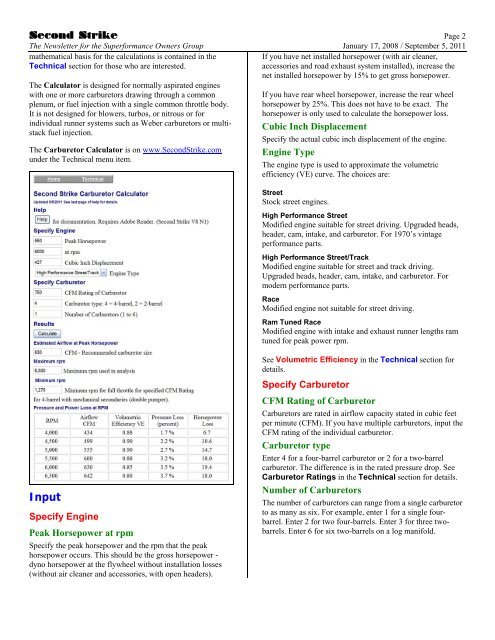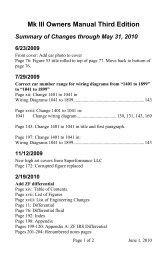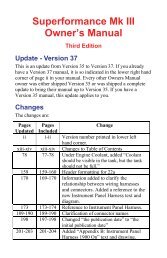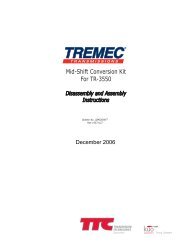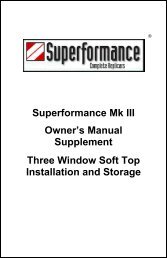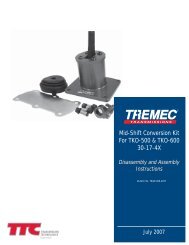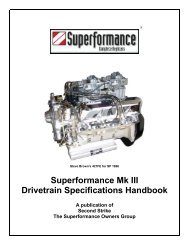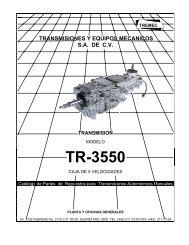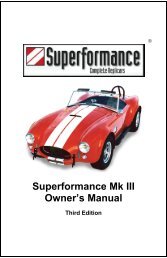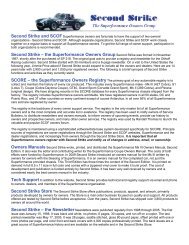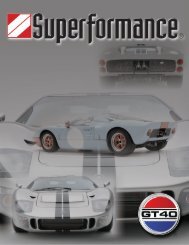Carburetor Calculator - Second Strike
Carburetor Calculator - Second Strike
Carburetor Calculator - Second Strike
Create successful ePaper yourself
Turn your PDF publications into a flip-book with our unique Google optimized e-Paper software.
<strong>Second</strong> <strong>Strike</strong> Page 2<br />
The Newsletter for the Superformance Owners Group January 17, 2008 / September 5, 2011<br />
mathematical basis for the calculations is contained in the<br />
Technical section for those who are interested.<br />
The <strong>Calculator</strong> is designed for normally aspirated engines<br />
with one or more carburetors drawing through a common<br />
plenum, or fuel injection with a single common throttle body.<br />
It is not designed for blowers, turbos, or nitrous or for<br />
individual runner systems such as Weber carburetors or multistack<br />
fuel injection.<br />
The <strong>Carburetor</strong> <strong>Calculator</strong> is on www.<strong>Second</strong><strong>Strike</strong>.com<br />
under the Technical menu item.<br />
If you have net installed horsepower (with air cleaner,<br />
accessories and road exhaust system installed), increase the<br />
net installed horsepower by 15% to get gross horsepower.<br />
If you have rear wheel horsepower, increase the rear wheel<br />
horsepower by 25%. This does not have to be exact. The<br />
horsepower is only used to calculate the horsepower loss.<br />
Cubic Inch Displacement<br />
Specify the actual cubic inch displacement of the engine.<br />
Engine Type<br />
The engine type is used to approximate the volumetric<br />
efficiency (VE) curve. The choices are:<br />
Street<br />
Stock street engines.<br />
High Performance Street<br />
Modified engine suitable for street driving. Upgraded heads,<br />
header, cam, intake, and carburetor. For 1970’s vintage<br />
performance parts.<br />
High Performance Street/Track<br />
Modified engine suitable for street and track driving.<br />
Upgraded heads, header, cam, intake, and carburetor. For<br />
modern performance parts.<br />
Race<br />
Modified engine not suitable for street driving.<br />
Ram Tuned Race<br />
Modified engine with intake and exhaust runner lengths ram<br />
tuned for peak power rpm.<br />
Input<br />
Specify Engine<br />
Peak Horsepower at rpm<br />
Specify the peak horsepower and the rpm that the peak<br />
horsepower occurs. This should be the gross horsepower -<br />
dyno horsepower at the flywheel without installation losses<br />
(without air cleaner and accessories, with open headers).<br />
See Volumetric Efficiency in the Technical section for<br />
details.<br />
Specify <strong>Carburetor</strong><br />
CFM Rating of <strong>Carburetor</strong><br />
<strong>Carburetor</strong>s are rated in airflow capacity stated in cubic feet<br />
per minute (CFM). If you have multiple carburetors, input the<br />
CFM rating of the individual carburetor.<br />
<strong>Carburetor</strong> type<br />
Enter 4 for a four-barrel carburetor or 2 for a two-barrel<br />
carburetor. The difference is in the rated pressure drop. See<br />
<strong>Carburetor</strong> Ratings in the Technical section for details.<br />
Number of <strong>Carburetor</strong>s<br />
The number of carburetors can range from a single carburetor<br />
to as many as six. For example, enter 1 for a single fourbarrel.<br />
Enter 2 for two four-barrels. Enter 3 for three twobarrels.<br />
Enter 6 for six two-barrels on a log manifold.


